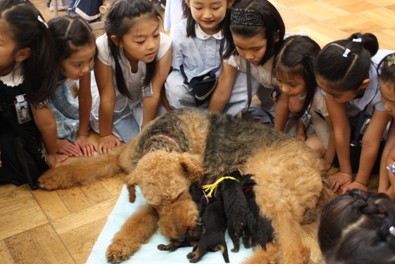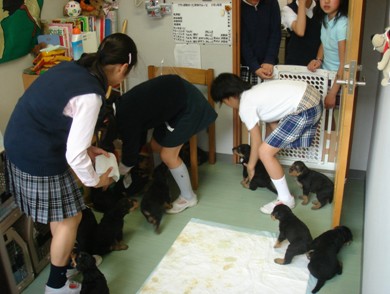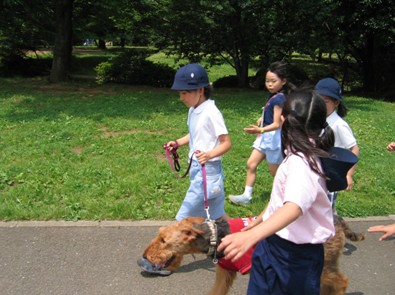Being touched by the birth of a new life
In our animal assisted education program, the event that most impressed the children may have been when Buddy delivered her puppies at school. In contemporary society, it has become easier for people to lose their sense of the real world, a feeling towards "life." However, Buddy gave us a valuable opportunity to become aware of one aspect of reality. The sexual maturation of dogs starts about the age of one year, and when female dogs go into their heat cycle, they have a bloody discharge from the vagina. In general, for reasons of safety and to avoid any trouble that might arise, female dogs in heat are not used for animal assisted activities at care facilities since they are likely to become emotionally unbalanced or overly aggressive at this time. Nevertheless, I decided to continue bringing Buddy to school even when she was in heat, and while it may sound insensitive, I thought that Buddy would be good "living educational material" for the children.
Buddy became pregnant twice, in 2006 and 2009. On both occasions, I took Buddy and her puppies to the classroom, and together with children, we were really fascinated to watch over the growth of the puppies.


Buddy passing the torch to a new generation
The average life span of an Airedale terrier is 12 - 14 years. Buddy is now six years old, just around the turning point of her life. We began to talk about a successor dog to Buddy as we felt we would need a new dog before she became too old. In the beginning, several other breeds were considered. German shepherds are easy to train; Australian shepherds are athletic, and the standard poodle sheds less hair. However, teachers and children strongly felt that they wanted a puppy related to Buddy, not dog bought from somewhere else.
In June 2009, we finally chose one puppy from the four in Buddy's second litter for our next school dog. Children named the puppy "Link," wishing to create a strong bond between the puppy and them.

The concept of animal assisted education in my mind actually differs from the conventional idea of having pet animals at school, where we see school children rearing rabbits or chicks in the pet house built in the corner of the schoolyard. Our animal assisted education does not intend to provide the experience of pet rearing (as this is a one-sided relationship with animals), nor does it intend to use animals as educational materials to be observed or to be used for experimentation. The aim of our education program, if I were to set a specific objective, is to somehow give children a way to build a solid emotional bond with Buddy, a dog who is an assistant in the everyday life of school and an animal with good communication abilities.
Animal assisted education will naturally and gradually have an effect in the daily life of children. It would therefore be inappropriate to measure its actual effect on them in numerical terms. "One-off" events such as having a dog visiting day or rental dog day at school, as well as inviting veterinarians or scholars to lecture on the ecology and lifestyle of cats and dogs may draw the children's attention for a while, but these experiences are not enough to realize and experience real communication with animals.
This is why animal assisted education should not be carried out according to the interests of researchers or the administrative authorities. Rather, to achieve effective outcomes, it is important that teachers take the time and trouble to keep an adorable animal within close reach of children and help them come into contact with the animal all the time. If we truly wish to nurture the emotional development of children through the animal assisted education, we should not work on this merely for academic research purposes.
My true goal is not to disseminate the animal assisted education in Japan. I have always dreamed of creating an education environment where as many children as possible can touch and feel the warmth of animals, thereby, recognizing that they are real "living" things. In fact, this was my motivation from the outset, and my principal objective has been to make a contribution to childhood development rather than to research. This underlying motivation has encouraged me to continue to develop my objective from the starting point of using a dog at St. Margaret's Elementary School in 2003 up to the present, 2010, over which time I have achieved some successful results. I think if we keep to the belief that this education is truly beneficial for children, along with a passion and strong will to accomplish this goal, we can change our world little by little, even if we as teachers are confined to the sphere of education where change seems to be blocked. I was lucky enough to receive warm understanding and support from many parents, and assistance from veterinarians and dog trainers. The luckiest thing is that, when discussing the implementation of this program, all teachers of the elementary school, both those who love and dislike dogs, agreed on one point: the ultimate goal is the well-being of children.
In trying to introduce animal assisted education into the curriculum, some school officials and educators may face much difficulty and inconvenience. I understand that it is hard to do something that has never been done before, but I truly hope they will not give up immediately. In such a case, my suggestion is to reflect on what you want to impart most to the children who are right in front of you, and what is most important for them. In the current educational environment in Japan, animal assisted education, which involves bringing a dog into the classroom as part of educational activities, may be almost impossible to start on your own. But, don't give up as you will eventually find someone who wishes, like you, to improve the well-being of children and their healthy growth through the concept of animal assisted education.
What I have learnt from the seven years of Animal Assisted Education at St. Margaret's Elementary School
Seven years have already passed since I started the animal assisted education at St. Margaret's Elementary School. Nowadays, parents and children often tell me that they enjoy school life so much because of Buddy and that Buddy relieves tension and makes them feel relaxed. Buddy, a school dog, does not work as a healer, but just being there gives pleasure and comfort to many children. She also serves as an intermediary between adults (teachers) and children as a catalyst for better communication. Buddy now motivates many children to attend school or to take on new challenges in the classroom. What Buddy has given us is tremendously beneficial in the realization of ideals in education where children can learn and share a sense of warm-hearted caring for each other through the animal presence of a dog like Buddy.















